德国交通标志大全_英文高清版
- 格式:pdf
- 大小:996.74 KB
- 文档页数:40
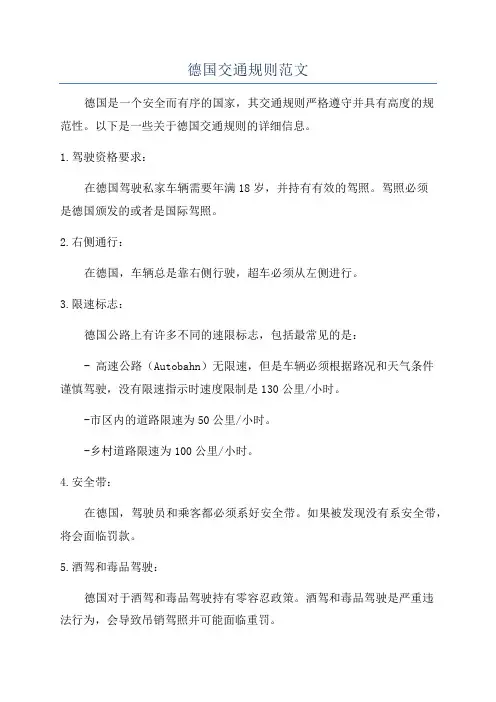
德国交通规则范文德国是一个安全而有序的国家,其交通规则严格遵守并具有高度的规范性。
以下是一些关于德国交通规则的详细信息。
1.驾驶资格要求:在德国驾驶私家车辆需要年满18岁,并持有有效的驾照。
驾照必须是德国颁发的或者是国际驾照。
2.右侧通行:在德国,车辆总是靠右侧行驶,超车必须从左侧进行。
3.限速标志:德国公路上有许多不同的速限标志,包括最常见的是:- 高速公路(Autobahn)无限速,但是车辆必须根据路况和天气条件谨慎驾驶,没有限速指示时速度限制是130公里/小时。
-市区内的道路限速为50公里/小时。
-乡村道路限速为100公里/小时。
4.安全带:在德国,驾驶员和乘客都必须系好安全带。
如果被发现没有系安全带,将会面临罚款。
5.酒驾和毒品驾驶:德国对于酒驾和毒品驾驶持有零容忍政策。
酒驾和毒品驾驶是严重违法行为,会导致吊销驾照并可能面临重罚。
6.手机使用:7.停车规则:在德国城市内停车需要特别注意停车标志和指示。
有些地区只允许在指定的时间段内停车,而其他地方可能需要购买停车券。
8.自行车:自行车在德国非常普遍且享有合法使用道路的权利。
驾驶者必须遵守交通规则,并且在夜间使用前后灯。
9.路边检查:在德国,经常会有路边检查,检查官员可能会检查驾驶员的驾照和车辆的相关文件。
如果没有合法的驾照或相关文件,驾驶员可能会被罚款或扣留车辆。
10.驶入学校区域:在德国,驾驶车辆不得驶入学校区域。
这些区域是为学生安全而设立的,车辆只能在指定的区域停车。
总的来说,德国交通规则对保障行车安全和车辆有序流动具有很高的重要性。
遵守交通规则是每位驾驶员的责任,也是每位行人的义务。
只有大家共同遵守规则,才能保证道路的安全和畅通。
如果违反交通规则,将面临罚款、驾驶执照被吊销以及其他严厉的处罚。
因此,无论是当地居民还是游客,都应该认真遵守德国的交通规则。
这不仅是尊重法律,也是对他人生命和财产安全的尊重。
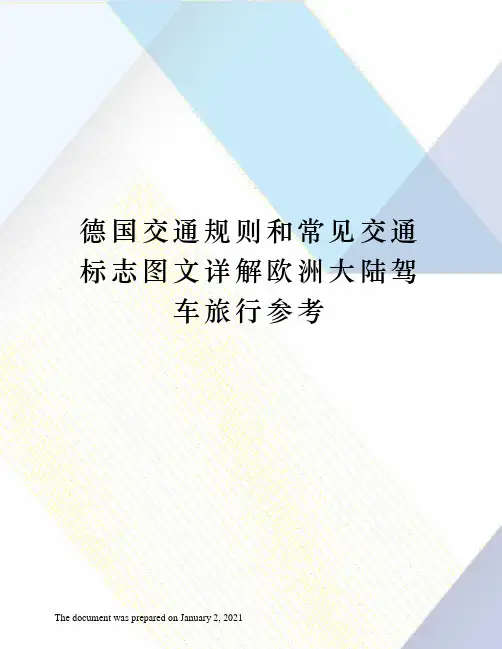
德国交通规则和常见交通标志图文详解欧洲大陆驾车旅行参考The document was prepared on January 2, 2021欧盟是世界上交通规则、交通标志最规范、交通管理最先进的的地区,而德国又是其中最典范的国家.平均每2个人就有一辆机动车,高速近半不限速,但事故率很低.此贴通过德国驾考的题目来详解德国和欧洲大陆多数国家的交通规则,图片均选自德国多个网站,我最早发在青岛新闻网青岛论坛,故图片印有“青青岛论坛”字样,现以长微博形势呈给大家,供准备在欧洲大陆驾车旅行的朋友参考.首先先认识几个很关键的交通标志和德国交通规则的核心:先行权路权是德国交通规则的核心,每个交通参与方都要知道在各种情况下何方有先行权.有红绿灯的路口,一切以红绿灯指示为准则,在车流量大的路段一定要设置红绿灯,但不同于国内的是,在欧盟右转车必须看信号灯指示,通常是跟直行车辆同灯放行,直行绿灯亮了,才可以右转大家可以想想为什么这么规定,但是有一个特例,当红绿灯下方设置一个绿色箭头的时候,即使是红灯,也可以在不影响直行车辆的情况下右转,但是这样的路口很少,多是设置在车流少的地方,车流大的地方右转车辆必须跟直行车辆同灯.在没有红绿灯的路口,要看先行权标志和让行标志,这个黄色实心竖立的矩形就是在欧洲很普遍的先行路权标志,切记,这个标志很重要,国内竟然没有在路上看到它,就意味着你在这条路上行驶有先行权有红绿灯的路口,先行标志失效,以红绿灯为准,不用担心路口会突然出来车,因为他们的路口有让行标志.还有一个重要的先行标志,它表示车辆在该路口有先行权这个就是让行标志,路口看到这个标志意味着你需要让行,这个标志国内有但国内却没有先行标志,有先行权的车怎么知道被让呢,不需要赘述,但是国内很少有人遵守,如果在欧洲不遵守的话很有可能车毁人亡.这个是交通辅助标志,一般放在道路先行权标志和让行标志的下方,放在先行权标志下方代表在这个路口左转时才有先行权,放在让行标志下面代表只需让行左转车辆.这个标志也很常见,需要图示在没有信号灯和其它标志的路口,严格遵循右边来车有先行权的原则,无论右边来的车是转向还是直行,都必须让它先走,否则出事负全责国内也有同样规定,这种没有信号和标志的“裸”路口通常车流很少.如果4个路口同时出现车辆几率很小,则需要打手势协商.认识了这几个标志和基本原则,我们进入德国驾考材料认识学习一下别人的交通制度.更多的交通标志请参考:下图中哪种行为是正确的1、a.我必须等待.b.绿色车必须等待.正确答案选a. 因为我前方有一个带辅助标志的让行标志,它们在一起表示,我必须让黑色粗线所指示的弯道内行驶车辆先行.2、a.我允许通过该路口 b.我必须等黄车通过正确答案选a.因为该路口有带辅助标志的先行路权标志,表示黑色粗线所示方向行驶的车有先行权,旁路的车都须让行,黄车前面树立着一个倒三角的让行标志,所以它会看标志主动让行.3、a.我必须等待 b.我允许在摩托车前通过路口正确答案是a.有了上面的示例,这里大家自然知道为什么了.摩托车的路边有一个左转先行权标志,我眼前是带辅助标志的让行标志,表示我必须让黑色粗线所指示路段内通行的车先行,这种情况一般是黑色粗线这个方向通行车辆较多,因此确保多数车的权益.而国内大多规定转弯让直行,辅道让主道,但实际上很多时候根本无法区分主道和辅道,尤其在一个陌生的地方,所以国内的规则是一种懒规则.4、a.减速并准备停下 b.继续前进上人行道通过 c.加速通过,因为对向车必须等待正确答案a. 因为图里的这个标志表示对向车有先行权.5、a.提前减速,让行人知道您已经给出了对方先行的信号.b.只要在人行道前停下即可正确答案为a.不要小看这2个答案的区别,路考的时候如果没有提前减速,必须重考.另外,堵车的时候必须让出人行横道,不得骑占.德国的人行横道通常没有红绿灯指示,这就意味着行人有绝对路权,有红绿灯的地方不会划人行横道线,而是两条平行虚线组成的通过区,行人和车辆全依信号灯通行,这种设计是为了更容易区别路权.6、a.减速,时刻准备刹车,小心通过.b.按喇叭并快速通过答案a.道理很简单.按喇叭在德国可不是一件好事,基本等同于骂人.7、a.我必须等待 b.从田间出来的车必须等待答案一定是b. 德国驾规规定,从路基外、步行道、院落、楼群加入交通的车辆必须让行.路考必考.8、上高速时,必须要在加速带上中国称辅路将速度升至多少公里才可以并入主道这个问题在德国是80kmh,因为这是德国高速的最低时速.中国应该是60kmh.此外,在加速带上要用3档加速,因为3档加速最快,如果考试的时候用其它档位在加速带加速会被考官判不过.9、高速公路上时速超过100kmh时,与前车的安全距离是多少这个问题的答案是:时速表数字的一半,例如时速在120kmh的时候,与前车的安全距离是60m,这样可以保证遇事能刹住车.10、两辆车都想停进这个车位,谁有优先权a.红车b.白车答案是a.两车争抢一个侧向车位时,倒车进入的有优先权,这种情况都有规定,够细.11、a.我必须等待 b.我必须让黄车通过答案a. 黄车和我的车前都有让行标志.但在相等路权情况下,左转让直行.12、如果白色小汽车没有停下等待,您应该怎么办a.减速并放弃先行权b.按喇叭并尝试在他之前通过答案a.避免事故发生,即使利益可能受损.13、这辆车明显低估了超车距离, 您该怎么办a.刹车并向右避让b.正常行驶答案a.原则同12.14、此处如何行为.a.立即减速并时刻准备刹车b.正常通过,因为孩子们肯定站在那里不动c.为了不影响后车,保持原速通过答案a. 时刻警惕可能出现的危险,人的生命永远第一位,尤其在居民区,一定要多观察,减速行驶.15、一辆车正在超越您,而对向来车越来越近,超车人并没有放弃超车,您怎么办a.减速,并尽可能靠右行驶b.保持原速答案a. 交通规则里的协作精神.16、什么是一个好的司机a.他需要有协作精神,平静并镇定的驾驶,不向人展示和炫耀过人的优势b.他急速行驶,以证明他的能耐c.他利用一切机会超车并紧跟前车以展示他的车技答案a.17、在三车道的路上听到急救车辆声音,应该如何行为a.最左道和中间道的车分别尽可能向左边和右边靠,以此让出一条急救通道b.中间道和右边道的车分别尽可能左靠和右靠,以便让出急救道答案a.这个是硬性规定,因为最右道往往有很多大车,难以腾出足够通道,而实际中,只要急救车在车辆后面,该车就有义务想尽办法躲让.18、您该想到什么a.个子矮的小孩可能随时从车间跑出来b.行人一定会等您通过再过马路答案a.记得2年前台东那里有个小朋友就是这样没了.19、您该想到什么a.在公交车前面可能会有小汽车b.右边开来一辆公交车答案a.周全的考虑是一个司机的职责20、如果建筑工地阻碍了道路一半通道,哪辆车必须等待a. 前方有障碍的车需要等待b. 路上无障碍的车需要等待答案a.交通规则的重要原则是保证车辆有序行驶,干扰正常行驶的车辆需要等待21、此情况下怎样同行a.我要让卡车通过b.我要让黄车轿车通过c.我允许在黄色轿车前通过这是个多选答案是a和b.这是个典型的没有信号和标志的裸路口,右边的车有先行权,所以我必须要让黄色轿车,卡车从黄色轿车的右边来,所以它要让卡车,而我要左转弯,左转会干扰正常秩序,干扰者必须等待,所以我必须等卡车和黄车通过后再转弯.这在德国是很经典的交通规则考试题目,特别实用的规则,同样也适用国内,因为中国也有类似规定,但多数不了解这个规则,很多人出了事故负全责后才知道还有这样的规定.真不知道驾校怎么教的.22、谁先行a.我必须让自行车先拐b.我必须让蓝车先走c.蓝车必须让我答案a和b.跟21类似,右边车有先行权,所以我必须让蓝车.自行车是顺向拐弯入路,而我是逆向拐弯入路,所以我是正常秩序的干扰者,我必须让自行车先拐,如果这里自行车换成汽车,同样适用该规则,注意,在这一点上中国的规定是:拐弯进入同一道路,逆向拐弯入道的有优先权,顺向的必须让,即右转让左转.而德国的规定是左转让右转,无论规则孰优孰劣关键在于了解后遵守,个人认为德国的规定更合理,所以我要在路口等待蓝车先过,再让自行车通过,然后才能驶入路口.那么蓝车和自行车谁有优先权呢,当然是自行车了,因为自行车在蓝车右边.23、谁让谁a.我必须让红车先行b.蓝车必须让我先行c.我必须让蓝车先行这个题的答案请感兴趣的朋友回答吧.也适合国内规则.24、遇到这个标志该注意什么a.在环岛内行驶的车辆有优先权b.离开环岛时需要打转向灯c.进入环岛时要打转向灯答案a和b.这个跟国内规定是一样的.即使环岛没有这样的标志也规定:环岛内的车有先行权,进入环岛的车必须让行环岛内行驶的车辆,离开环岛必须打转向灯.实际上有的环岛很大,比如巴黎凯旋门和柏林胜利柱的环岛都是4-5个车道的,周边路口近10个,车要离开环岛进入其他道路会比较混乱,所以柏林在环岛内为车辆专门设置了红绿灯,这样就就很有秩序了.我们海信立交桥的那个环岛就有些类似,乱的很.25、行人要从人行道穿过马路,您该怎么做a.减速慢行靠近人行道,如有必要停下等待b.不能抢过c.如果行人还没走上人行道可以抢过答案a和b.行人走人行道是拥有绝对的优先权,车辆不可以做出让行人感到恐慌的举动,否则肯定会被行人和其它司机问候.这种行人至上的题目在德国驾照考取过程中贯穿始终,考驾照很贵的,所以大家格外小心.很多东西习惯了就成自然了.26、变道时和转弯时应注意什么.a.开转向灯并提前观察观后镜b.扭头观察侧后方c.仅看观后镜即可答案选a和b.对于a大家没什么异议.但是在德国学及考驾照时教练和考官会观察你转弯和变道时有否侧头观察后门窗户位置.因为观后镜有死角,后门位置的车辆是看不到的,而很多擦碰事故就是因此产生的,因此必须要在变道和转弯时扭头观察侧后方.如果没有做出这个动作或者忘了做,那对不起,2个月后再交500欧重新考试吧.27、您允许超越自行车队吗a.不,因为您没有足够的超车视野b.不,因为在对向有车的情况下您难以保证和自行车的安全距离c.可以,因为对向来车会让我.答案a和b. 德国规定,在没有自行车道的时候,自行车可以在机动车道行驶,机动车必须要跟自行车保持1米以上的距离.28、如果您的车正在被超越,应该注意什么a.不要加速b.尽可能靠右答案选a. 这个不用多说了,交通里的协作精神.29、在不影响公交车行驶的情况下,公交车站可以短暂停车,最长可以停多久.答案是3分钟.仅限德国境内30、如果您的车在隧道遇到故障该怎么办a、打开应急灯双闪b、尽可能将车停进救助道. c.不要关闭发动机答案a和b.此外还应该在车后50米处设置故障警示架高速公里上需要在100米处设置不关发动机会在隧道产生废气,影响健康和安全.31、您听到急救车辆的警笛,此时应想到什么问题a.急救车从哪里过来b.我是否阻碍了急救车c.这个急救车允许用警笛吗答案a和b.我们每个人都该注意的问题32、不系安全带有什么危险a.因为在车速20kmh以上时遇到追尾事故就可能出现受伤危险b.因为高速驾驶遇事故时人可能被甩出c.在城区速度低不危险答案a和b.德国规定车里的所有乘客必须系安全带,即使是客车也有此要求,更不用说小汽车了,小孩乘车必须使用安全座椅,否则重罚.而我们的管理者还在研究副驾驶位置不系安全带是否算违章的问题,有那么难吗.33、这个路口应该注意什么a.右边来车b.刹车路径可能因为湿滑地面而延长c.右边来车可能会放弃它的先行权.34、您想右转却不小心进错了道,您该怎么办a.直行或左转b.小心的右转答案a.实线了,不允许再变道,否则影响正常秩序,只能绕圈重走了.这个图里大家可以看到,信号灯的位置是基本和停车线垂直的,为了防止有大型车辆的时候视线被当,右边和上方都设置了红绿灯,有的路口左边也设立,这种垂直而不是放在对面设计的原则是:防止在堵车时绿灯通行车辆仍然进入路口,在晚上光线差的时候、没有路灯的时候和道路标线缺失的时候,告诉汽车该在哪里停车等红灯.35、在左转后您想接着右转,您该跟哪车道a.红车所在的道b.绿车的道c.像蓝车一样答案a.驾驶员要会提前预判、36、谁有先行权a.我必须等待b.黄车必须等待答案a.先行标志显示,弯道行驶的车辆有优先权,我是左转,不在弯道内.根据车流量的多少来确定让那条路有先行权是保障多数车路权的方法.这种情况我们平时经常遇到,国内这样的路段很多,但是我们没有这种便捷的标志,无法保障多数车的权益,出了事故都不好定责.37、在高速路上遇到堵车了,您该怎么办a.尽可能靠左行驶,以便中间让出通道给可能出现的急救车辆b.尽可能靠中间,观察堵车原因c.到应急车道上继续开答案a.其它常见标志:这个标记常出现在比较窄的道路上,尤其是修路时.表示顺向车有先行权,对向来车须让我先行.这个表示进入城镇,最高时速50kmh.这个标志表示对向来车有先行权,顺向车需要让行.离开此城镇,下一个城镇距离6公里这种标志很多路口都有,下面的这个表示只能直行那这个就代表只能直行和右转这种蓝色带数字的标志表示最低时速30kmh,这种规定最低时速的标志很少见.但是在高速上行驶的小汽车不得低于80kmh,这个不需要标志,因为教材里已经规定了.这个不用多说了,必须停够3秒才可以同行.这个美国比较多进入居民区,以20kmh以下的速度慢行. 步行街标志,机动车禁止.机动车禁行标志单行线标志禁止驶入,多用于单行线的路口此路禁行,跟上一个符号的作用类似当心,有对向交通前方240处有铁路,每道红杠代表80米. 禁止超车路段结束前方路口变窄当心弯道连续弯道。
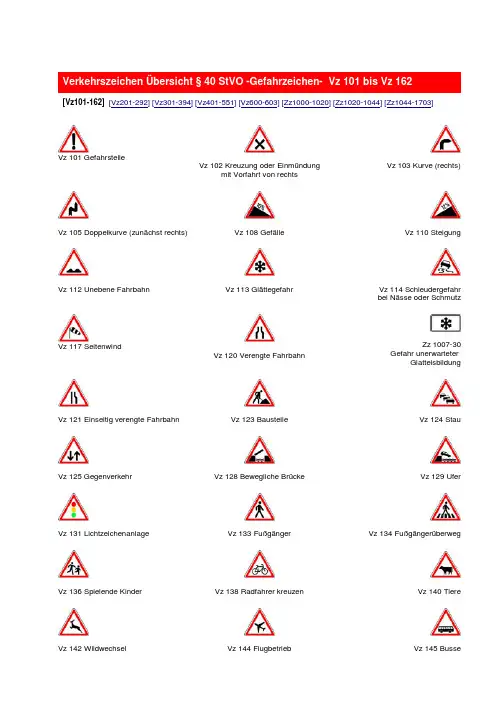
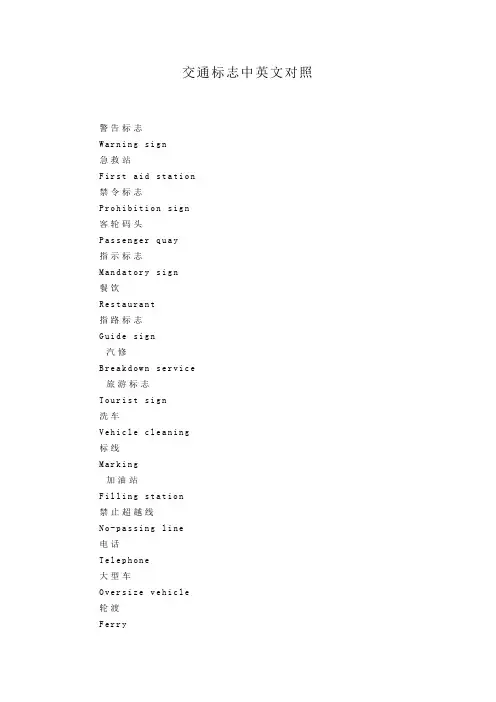
交通标志中英文对照警告标志W a r n i n g s i g n急救站F i r s t a i d s t a t i o n禁令标志P r o h i b i t i o n s i g n客轮码头P a s s e n g e r q u a y指示标志M a n d a t o r y s i g n餐饮R e s t a u r a n t指路标志G u i d e s i g n汽修B r e a k d o w n s e r v i c e旅游标志T o u r i s t s i g n洗车V e h i c l e c l e a n i n g标线M a r k i n g加油站F i l l i n g s t a t i o n禁止超越线N o-p a s s i n g l i n e电话T e l e p h o n e大型车O v e r s i z e v e h i c l e轮渡F e r r yL i g h t-d u t y v e h i c l e爬坡车道C l i m b i n g l a n e自行车B i c y c l e追尾危险R e a r-e n d c o l l i s i o n d a n g e r 非机动车N o n-m o t o r v e h i c l e保持车距K e e p s p a c e公共汽车B u s道路交通信息T r a f f i c i n f o r m a t i o n机动车M o t o r v e h i c l e路面结冰I c y p a v e m e n t公共汽车优先B u s p r e e m p t i o nB u s p r i o r i t y小心路滑S l i p p e r y r o a d b e c a r e f u l 行车道R o a d w a y,c a r r i a g e w a y陡坡慢行S t e e p d e s c e n t,s l o w-d o w n超车道O v e r t a k i n g l a n e多雾路段F o g g y s e c t i o n硬路肩H a r d s h o u l d e rW e a k s u b g r a d e国道N a t i o n a l r o a d大型车靠右O v e r s i z e v e h i c l e t o r i g h t 省道P r o v i n c i a l r o a d注意横风A l e r t t o c r o s s w i n d县道C o u n t y r o a d事故多发点B l a c k s p o t高速公路E x p r e s s w a y保护动物P r o t e c t a n i m a l起点S t a r t i n g p o i n t长下坡慢行L o n g d e s c e n t,s l o w-d o w n终点E n d p o i n t道路封闭R o a d c l o s e d一般道路O r d i n a r y r o a d车道封闭L a n e c l o s e d城市道路U r b a n r o a d车辆慢行S l o w d o w n**街道**s t r e e t道路施工R o a d c o n s t r u c t i o n, R o a d w o r k s互通式立交**i n t e r c h a n g e车辆绕行V e h i c l e b y-p a s s高架桥V i a d u c t方向引导D i r e c t i o n g u i d e隧道T u n n e l落石F a l l i n g r o c k s收费站T o l l s t a t i o n双向交通T w o-w a y t r a f f i c应急停车带E m e r g e n c y s t o p a r e a 其他危险O t h e r d a n g e r s休息处R e s t a r e a道路或车道变窄C a r r i a g e w a y n a r r o w s服务区S e r v i c e a r e a堤坝路E m b a n k m e n t r o a d避车道L a y-b y,P a s s i n g b a y 限制高度L i m i t e d h e i g h t火车站R a i l w a y s t a t i o n限制宽度L i m i t e d w i d t h飞机场A i r p o r t禁鸣喇叭S i l e n c e(N o a u d i b l e w a r n i n g)停车场P a r k i n g渡船F e r r y b o a t长途汽车站I n t e r-c i t y b u s s t a t i o n此路不通N o t h r o u g h r o a d警告标志|| Warning sign禁令标志|| Prohibition sign指示标志|| Mandatory sign指路标志|| Guide sign旅游标志|| Tourist sign标线|| Marking禁止超越线|| No-passing line大型车|| Oversize vehicle小型车|| Light-duty vehicle自行车|| Bicycle非机动车|| Non-motor vehicle公共汽车|| Bus机动车|| Motor vehicle公共汽车优先|| Bus preemptionBus priority行车道|| Roadway,carriageway超车道|| Overtaking lane硬路肩|| Hard shoulder国道|| National road省道|| Provincial road县道|| County road高速公路|| Expressway起点|| Starting point终点|| End point一般道路|| Ordinary road城市道路|| Urban road**街道|| * * street互通式立交|| * * interchange高架桥|| Viaduct隧道|| Tunnel收费站|| Toll station应急停车带|| Emergency stop area休息处|| Rest area服务区|| Service area避车道|| Lay-by,Passing bay火车站|| Railway station飞机场|| Airport停车场|| Parking长途汽车站|| Inter-city bus station急救站|| First aid station客轮码头|| Passenger quay餐饮|| Restaurant汽修|| Breakdown service洗车|| Vehicle cleaning加油站|| Filling station电话|| Telephone轮渡|| Ferry爬坡车道|| Climbing lane追尾危险|| Rear-end collision danger 保持车距|| Keep space道路交通信息|| Traffic information路面结冰|| Icy pavement小心路滑|| Slippery road be careful陡坡慢行|| Steep descent,slow-down多雾路段|| Foggy section软基路段|| Weak subgrade大型车靠右|| Oversize vehicle to right 注意横风|| Alert to cross wind事故多发点|| Blackspot保护动物|| Protect animal长下坡慢行|| Long descent,slow-down道路封闭|| Road closed车道封闭|| Lane closed车辆慢行|| Slow down道路施工|| Road construction,Road works车辆绕行|| Vehicle by-pass方向引导|| Direction guide落石|| Falling rocks双向交通|| Two-way traffic其他危险|| Other dangers道路或车道变窄|| Carriageway narrows 堤坝路|| Embankment road限制高度|| Limited height限制宽度|| Limited width禁鸣喇叭|| Silence(No audible warning) 渡船|| Ferry boat此路不通|| No through road。
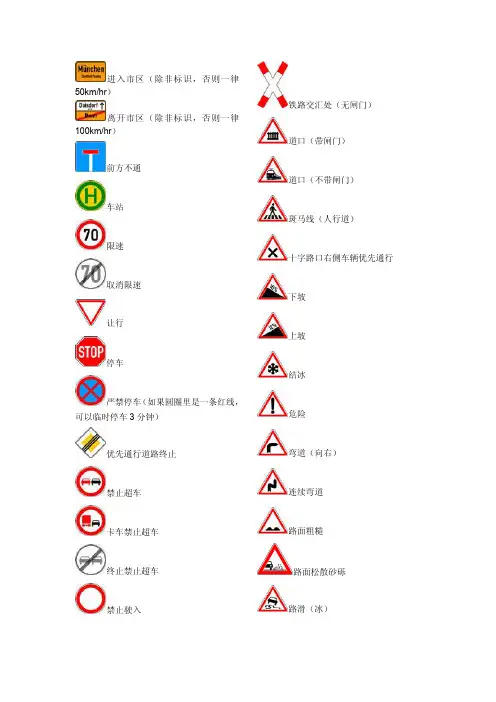
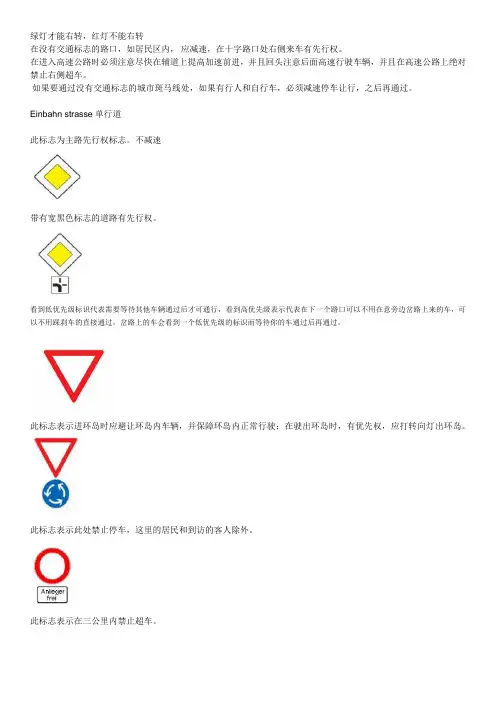
绿灯才能右转,红灯不能右转
在没有交通标志的路口,如居民区内,应减速,在十字路口处右侧来车有先行权。
在进入高速公路时必须注意尽快在辅道上提高加速前进,并且回头注意后面高速行驶车辆,并且在高速公路上绝对禁止右侧超车。
如果要通过没有交通标志的城市斑马线处,如果有行人和自行车,必须减速停车让行,之后再通过。
Einbahn strasse单行道
此标志为主路先行权标志。
不减速
带有宽黑色标志的道路有先行权。
看到低优先级标识代表需要等待其他车辆通过后才可通行,看到高优先级表示代表在下一个路口可以不用在意旁边岔路上来的车,可以不用踩刹车的直接通过,岔路上的车会看到一个低优先级的标识而等待你的车通过后再通过。
此标志表示进环岛时应避让环岛内车辆,并保障环岛内正常行驶;在驶出环岛时,有优先权,应打转向灯出环岛。
此标志表示此处禁止停车,这里的居民和到访的客人除外。
此标志表示在三公里内禁止超车。
此标志表示注意人行横道上的行人,注意停车时间有2个小时。
此标志表示在下一个十字路口以及引导口将会有先行权。
此标志表示停车让路。
一定要停住,小心看。
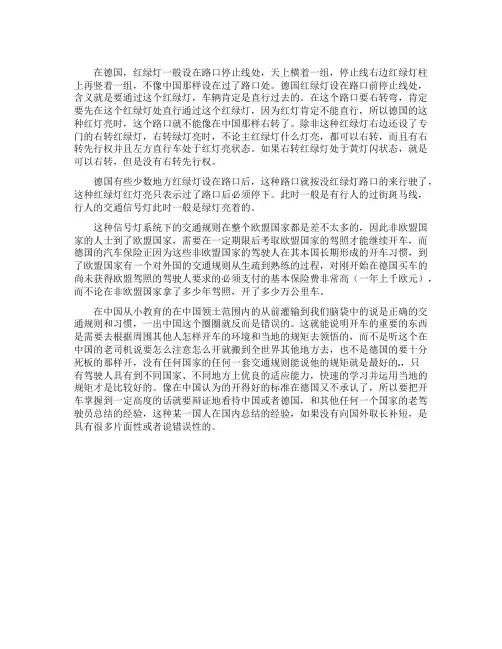
在德国,红绿灯一般设在路口停止线处,天上横着一组,停止线右边红绿灯柱上再竖着一组,不像中国那样设在过了路口处。
德国红绿灯设在路口前停止线处,含义就是要通过这个红绿灯,车辆肯定是直行过去的。
在这个路口要右转弯,肯定要先在这个红绿灯处直行通过这个红绿灯,因为红灯肯定不能直行,所以德国的这种红灯亮时,这个路口就不能像在中国那样右转了。
除非这种红绿灯右边还设了专门的右转红绿灯,右转绿灯亮时,不论主红绿灯什么灯亮,都可以右转,而且有右转先行权并且左方直行车处于红灯亮状态。
如果右转红绿灯处于黄灯闪状态,就是可以右转,但是没有右转先行权。
德国有些少数地方红绿灯设在路口后,这种路口就按没红绿灯路口的来行驶了,这种红绿灯红灯亮只表示过了路口后必须停下。
此时一般是有行人的过街斑马线,行人的交通信号灯此时一般是绿灯亮着的。
这种信号灯系统下的交通规则在整个欧盟国家都是差不太多的,因此非欧盟国家的人士到了欧盟国家,需要在一定期限后考取欧盟国家的驾照才能继续开车,而德国的汽车保险正因为这些非欧盟国家的驾驶人在其本国长期形成的开车习惯,到了欧盟国家有一个对外国的交通规则从生疏到熟练的过程,对刚开始在德国买车的尚未获得欧盟驾照的驾驶人要求的必须支付的基本保险费非常高(一年上千欧元),而不论在非欧盟国家拿了多少年驾照,开了多少万公里车。
在中国从小教育的在中国领土范围内的从前灌输到我们脑袋中的说是正确的交通规则和习惯,一出中国这个圈圈就反而是错误的。
这就能说明开车的重要的东西是需要去根据周围其他人怎样开车的环境和当地的规矩去领悟的,而不是听这个在中国的老司机说要怎么注意怎么开就搬到全世界其他地方去,也不是德国的要十分死板的那样开,没有任何国家的任何一套交通规则能说他的规矩就是最好的.,只有驾驶人具有到不同国家、不同地方上优良的适应能力,快速的学习并运用当地的规矩才是比较好的。
像在中国认为的开得好的标准在德国又不承认了,所以要把开车掌握到一定高度的话就要辩证地看待中国或者德国,和其他任何一个国家的老驾驶员总结的经验,这种某一国人在国内总结的经验,如果没有向国外取长补短,是具有很多片面性或者说错误性的。
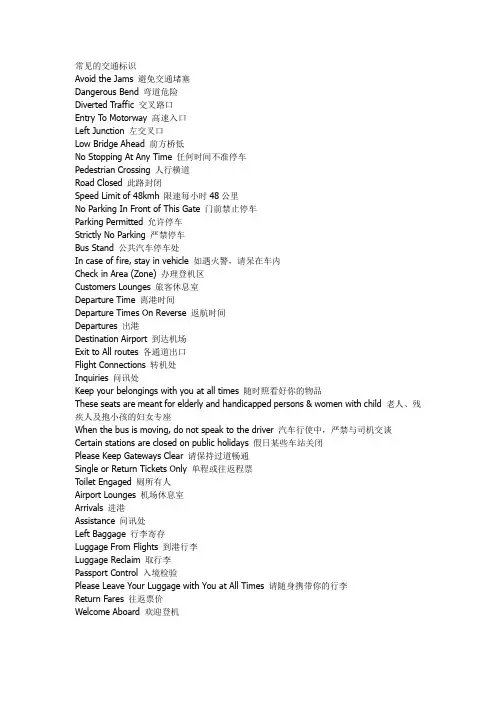
常见的交通标识Avoid the Jams 避免交通堵塞Dangerous Bend 弯道危险Diverted Traffic 交叉路口Entry To Motorway 高速入口Left Junction 左交叉口Low Bridge Ahead 前方桥低No Stopping At Any Time 任何时间不准停车Pedestrian Crossing 人行横道Road Closed 此路封闭Speed Limit of 48kmh 限速每小时48公里No Parking In Front of This Gate 门前禁止停车Parking Permitted 允许停车Strictly No Parking 严禁停车Bus Stand 公共汽车停车处In case of fire, stay in vehicle 如遇火警,请呆在车内Check in Area (Zone) 办理登机区Customers Lounges 旅客休息室Departure Time 离港时间Departure Times On Reverse 返航时间Departures 出港Destination Airport 到达机场Exit to All routes 各通道出口Flight Connections 转机处Inquiries 问讯处Keep your belongings with you at all times 随时照看好你的物品These seats are meant for elderly and handicapped persons & women with child 老人、残疾人及抱小孩的妇女专座When the bus is moving, do not speak to the driver 汽车行使中,严禁与司机交谈Certain stations are closed on public holidays 假日某些车站关闭Please Keep Gateways Clear 请保持过道畅通Single or Return Tickets Only 单程或往返程票Toilet Engaged 厕所有人Airport Lounges 机场休息室Arrivals 进港Assistance 问讯处Left Baggage 行李寄存Luggage From Flights 到港行李Luggage Reclaim 取行李Passport Control 入境检验Please Leave Your Luggage with You at All Times 请随身携带你的行李Return Fares 往返票价Welcome Aboard 欢迎登机不同国家,交通标识牌也有很大的区别,但根据其语言特点和设计特点,大部分都能很容易地得到识别。
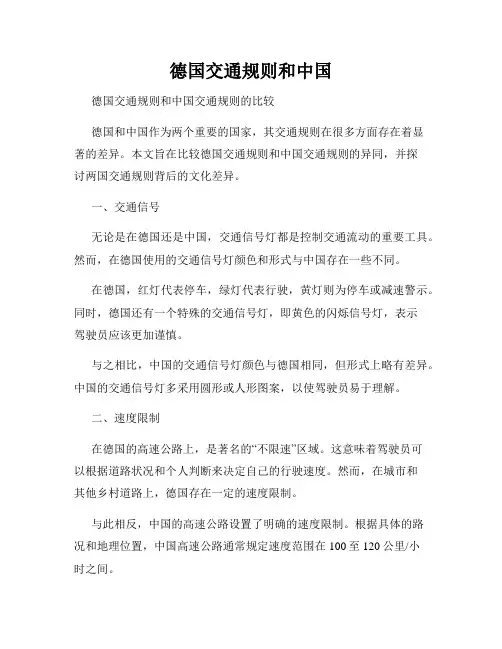
德国交通规则和中国德国交通规则和中国交通规则的比较德国和中国作为两个重要的国家,其交通规则在很多方面存在着显著的差异。
本文旨在比较德国交通规则和中国交通规则的异同,并探讨两国交通规则背后的文化差异。
一、交通信号无论是在德国还是中国,交通信号灯都是控制交通流动的重要工具。
然而,在德国使用的交通信号灯颜色和形式与中国存在一些不同。
在德国,红灯代表停车,绿灯代表行驶,黄灯则为停车或减速警示。
同时,德国还有一个特殊的交通信号灯,即黄色的闪烁信号灯,表示驾驶员应该更加谨慎。
与之相比,中国的交通信号灯颜色与德国相同,但形式上略有差异。
中国的交通信号灯多采用圆形或人形图案,以使驾驶员易于理解。
二、速度限制在德国的高速公路上,是著名的“不限速”区域。
这意味着驾驶员可以根据道路状况和个人判断来决定自己的行驶速度。
然而,在城市和其他乡村道路上,德国存在一定的速度限制。
与此相反,中国的高速公路设置了明确的速度限制。
根据具体的路况和地理位置,中国高速公路通常规定速度范围在100至120公里/小时之间。
三、交通标志德国的交通标志与中国的交通标志存在着明显的差异。
德国的交通标志一般采用蓝底白字,以配合欧洲的标准化。
与之不同,中国的交通标志通常采用红底白字,以突出中国的国情和文化。
此外,德国和中国在交通标志使用上也存在一些细微差别。
例如,在德国交叉路口的标志上,一般只标示主要方向,而中国交叉路口的标志则通常会标示全部行驶方向,以便驾驶员更好地做出决策。
四、行人优先原则在德国的交通规则中,行人享有较高的优先权。
驾驶员必须在人行横道前停车,以便行人安全通过。
与此相比,中国的交通规则对行人的保护程度相对较低。
尽管中国也设有人行横道,但很多时候驾驶员并不会停车让行人通过。
文化背景下的交通规则差异德国和中国的交通规则差异不仅仅是法规和制度层面上的区别,背后也反映了两国的文化背景。
德国作为一个注重纪律和规范的国家,其交通规则强调的是安全和秩序。

警告牌:小心,危险地注意这里右先左行驶小心道路不平小心,拐弯处小心,两个拐弯处小心,路湿或路面弄脏时翻车小心,有侧吹风小心道路变窄小心,一侧道路变窄小心,施工地容易出现堵车现在开始双向行驶小心野兽出没前方红绿灯小心行人小心儿童小心斑马线小心火车道(有栏杆)小心火车道(无栏杆)指路牌:火车道没有先行权,左右都要让停!左右都要让,没有先行权主路走向(主路的车有先行权)对面的车有先行权方向牌:道路方向环岛单行线最边上的道可行; 不可行;并道公车站出租车位自行车道,骑马道,行人道禁止所有车辆进入禁止汽车进入禁止卡车进入禁止汽车和动力车进入禁止5,5吨及以上实际重量的车辆进入禁止宽2米的车辆进入禁止高3,8米以上的车辆进入禁止车长10米的车辆进入禁止驶入禁止掉头限速60公里/每小时限速30公里/每小时区;取消限速禁止超车取消60公里/每小时限速取消禁止超车禁止停放车禁止停放车超过3分钟,可短时间停靠道路标志牌:此处路口有先行权主路(有先行权)主路结束(开始右先左规则)比对面行使车辆有先行权进入Wilster镇(主路限速50公里/每小时)离开Wilster镇,前方6公里Schotten镇(取消限速50公里/每小时)停车场开始进入住宅区(限速10公里/每小时);离开住宅区高速公路(此牌子放置在进入高速公路前处)公路(最高速应为100公里/每小时)高速公路出口方向Mainz,Wiesbaden的高速公路出口高速公路结束公路结束隧道(注意开灯,不允许掉头)人行横道紧急情况允许在此处停靠车地下通道或天桥死胡同高速公路旅馆;高速公路饭馆,高速公路便利店高速公路指向方向路程预告牌方向预告牌开往高速公路的方向预告牌高速公路上的通告牌(前方1000米Düsseldorf 方向的出口)高速公路出口的通告牌300米处高速公路出口提醒路程通告牌(距köln106公里,距Dormund24公里)道路封闭,绕行标志。
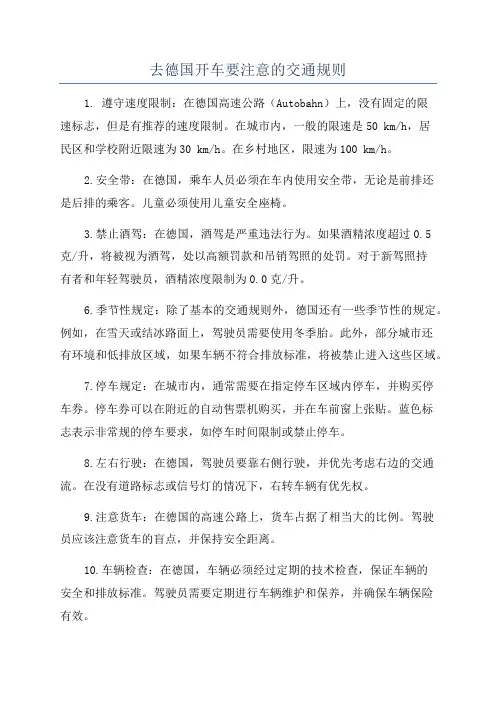
去德国开车要注意的交通规则1. 遵守速度限制:在德国高速公路(Autobahn)上,没有固定的限速标志,但是有推荐的速度限制。
在城市内,一般的限速是50 km/h,居民区和学校附近限速为30 km/h。
在乡村地区,限速为100 km/h。
2.安全带:在德国,乘车人员必须在车内使用安全带,无论是前排还是后排的乘客。
儿童必须使用儿童安全座椅。
3.禁止酒驾:在德国,酒驾是严重违法行为。
如果酒精浓度超过0.5克/升,将被视为酒驾,处以高额罚款和吊销驾照的处罚。
对于新驾照持有者和年轻驾驶员,酒精浓度限制为0.0克/升。
6.季节性规定:除了基本的交通规则外,德国还有一些季节性的规定。
例如,在雪天或结冰路面上,驾驶员需要使用冬季胎。
此外,部分城市还有环境和低排放区域,如果车辆不符合排放标准,将被禁止进入这些区域。
7.停车规定:在城市内,通常需要在指定停车区域内停车,并购买停车券。
停车券可以在附近的自动售票机购买,并在车前窗上张贴。
蓝色标志表示非常规的停车要求,如停车时间限制或禁止停车。
8.左右行驶:在德国,驾驶员要靠右侧行驶,并优先考虑右边的交通流。
在没有道路标志或信号灯的情况下,右转车辆有优先权。
9.注意货车:在德国的高速公路上,货车占据了相当大的比例。
驾驶员应该注意货车的盲点,并保持安全距离。
10.车辆检查:在德国,车辆必须经过定期的技术检查,保证车辆的安全和排放标准。
驾驶员需要定期进行车辆维护和保养,并确保车辆保险有效。
总之,去德国开车需要遵守速度限制,使用安全带,禁止酒驾和使用手机。
在交通事故发生时,要及时停车并采取相应措施。
此外,还要注意季节性规定、停车规定、行车方向和货车等问题。
在德国开车需要遵守交通规则,确保自己和他人的安全。
道路交通英文指示牌标识汇总1爬坡车道Steep Grade2长下坡慢行Steep Slope-Slow Down3陡坡减速Steep Incline-Slow Down4追尾危险Don't Follow Too Closely5小心路滑Slippery When Wet6保持车距Maintain Safe Distance7事故多发点Accident Area8保护动物Watch for Animals9道路交通信息Traffic Information10多雾路段Foggy Area11软基路段Soft Roadbed12堤坝路Embankment Road13明槽路段Underpass14深槽路段Underpass15道路封闭Road Closed16车辆慢行Slow Down17道路施工Road Work Ahead18车辆绕行Detour19前方弯道Bend Ahead20方向引导Direction Sign21落石Falling Rocks22双向交通Two-Way Traffic23单行交通One-Way Traffic24禁止驶入/严禁通行/禁止入洞No Entry 25禁止超越线No Passing26此路不通Dead End27道路或车道变窄Road /Lane Narrows28道路两侧变窄Road Narrows on Both Sides 29道路左侧变窄Road Narrows on Left30道路右侧变窄Road Narrows on Right31换乘(出租车、公交)Transfer32设施服务时间Service Hours33禁鸣喇叭No Horn34停车领卡Stop for Ticket35大型车靠右Large Vehicles Keep Right36公共汽车优先Bus Priority37请系好安全带Buckle Up38严禁酒后开车Don't Drink and Drive39请勿疲劳驾驶Don't Drive When Tired40禁扔废弃物No Littering41禁用手机Don't Use Cellphones When Driving 42禁止超载Don't Exceed Weight Limit43禁止超高Don't Exceed Height Limit44严禁超速Don't Exceed Speed Limit45专心驾驶谨防追尾Drive Carefully46请按车道行驶/分道行驶Use Correct Lane47紧急情况请拨打XXX Call XXX in Emergency48前方500m进入无路灯路段No Road Lights after 500 m 49无路灯路段全长9km No Road Lights for 9 km50路面结冰Icy Road51注意横风Danger! Cross Wind52车道封闭Lane Closed53其他危险Other Dangers54前方学校School Zone55让Yield56停Stop57警告标志Warning Sign58禁令标志Prohibition Sign59指示标志Mandatory Sign60指路标志Guide Sign61旅游标志Tourist Sign62禁止摆卖Vendors Prohibited/No Vendors63禁止跳下Stay Clear from Tracks64暂停售票Temporarily Closed65禁止翻越No Crossing66请勿挤靠Keep Clear of the Door67请勿登踏Don't Step On68注意安全,请勿靠近Keep Away for Safety69服务区域Service Area70办公区域Administrative Area71当心夹手Watch Your Hand72贵重物品,随身携带Please Don't Leave Valuables Unattended 73电梯故障停运正在维修,请原谅Escalator under repair. Sorry for the inconvenience.74施工(检修)给您带来不便请原谅Under construction (repair). Sorry for the inconvenience.75正在检修,请绕行Detour Maintenance in Progress.76正在检修,请您稍候Wait. Maintenance in Progress.77电梯维修,暂停使用Escalator Out of Service78靠右站立、左侧疾行Stand on Right. Pass on Left.79紧急时击碎玻璃Break Glass in Emergency80请勿手扶Don't Touch81请勿挤靠车门,以免发生危险For your safety, please keep clear of the door.82为了行车安全,请勿打扰司机Don’t Distract the Driver83车内发生紧急情况时,请按按钮报警Press Button inEmergency84按下红色按钮,绿灯亮时对准话筒报警Press red button, wait for green light and speak into the microphone.85仅供紧急情况下使用Emergency Use Only86请在前后门下车Please Get Off at the Front or Rear Door87下车请刷卡Please Swipe Card Before Getting Off88严禁非本部门人员入内Staff Only89行人绕行No Through Route for Pedestrians/Pedestrians Detour 90雨雪天气请慢行Drive Slowly in Rain or Snow91注意行人Watch Out for Pedestrians92减速慢行,避让行人Slow Down. Give Way to Pedestrians93消防通道,禁止停车Fire Engine Access. No Parking.94出口请慢行Slow Down at Exit95请停车入位Park in Bays Only96转弯慢行Turn Ahead-Slow Down97换乘(机场、火车站)Transit道路与车辆信息1道(大道)Avenue (Ave)2干道Main Rd3国道National Rd4省道Provincial Rd5县道County Rd6一般道路Ordinary Rd7城市道路Urban Rd8路Road (Rd)9辅路Side Rd10支路Access Rd11公路Highway12高速公路Expressway (Expwy)13东路East Rd14南路South Rd15西路West Rd16北路North Rd17中路Middle Rd18环路Ring Rd19东(南、西、北)二环 E. (S. W. N.) 2nd Ring Rd20东南(东北、西南、西北)二环South E. (North E. South W. North W.) 2nd Ring Rd21东(西)二环南(北)路E. (W.) 2nd Ring Rd South (North)22南(北)二环东(西)路S. (N.) 2nd Ring Rd East (West)23东二环辅路Side Rd of E. 2nd Ring Rd24三环路3rd Ring Rd25四环路4th Ring Rd26五环路5th Ring Rd27六环路6th Ring Rd28街(大街)S treet (St)29小街(条、巷、夹道)Alley30东街East St31南街South St32西街West St33北街North St34前街Front St35后街Back St36中街Middle St37上街Upper St38内大街Inner St39外大街Outer St40斜街Byway41胡同Hutong42里(芳园北里)LI (FANGYUAN BEILI)43区(芳城园二区)QU (FANGCHENGYUAN ERQU) 44园(惠谷根园)YUAN (HUIGUGENYUAN)45桥Bridge461桥Bridge 1472桥Bridge 248环岛Roundabout49小型车道Car Lane50大型车道Large Vehicle Lane51行车道Through Lane52避车道Lay-by/Passing Bay53应急车道Emergency Vehicle Lane54大型车Large Vehicle55小型车Car56非机动车Non-Motor Vehicle57机动车Motor Vehicle58自行车Bicycle59硬路肩Hard Shoulder60软路肩Soft Shoulder61起点Start62终点End63隧道Tunnel64应急停车带Emergency Stop Area注:仅用于长安街、平安大街和两广路。
世界名车德国名车塞特拉SETRA塞特拉(SETRA)是德国奔驰集团旗下的顶级大客车品牌。
小奇迹DKW奥迪四环徽标中其中一环就是指小奇迹(DKW)汽车。
霍希霍希Horch奥迪四环徽标中其中一环就是指霍希(Horch)汽车。
RUFRUF是一家专门改装保时捷的德国公司。
曼MAN曼恩集团是欧洲著名的载重汽车、发动机、机械制造公司。
法国名车雷诺Renault雷诺公司以创始人路易斯·雷诺(Louis Renault)的姓氏而命名,图形商标是四个菱形拼成的图案,象征雷诺三兄弟与汽车工业融为一体,表示“雷诺”能在无限的(四维)空间中竞争、生存、发展。
雪铁龙CITROEN1900年,年仅22岁的安德烈·雪铁龙在波兰旅行时偶然发现了一种人字型齿轮切割方法,并立即购买了这项专利。
从此,这种人字型条纹齿轮便成为了雪铁龙公司的象征,也是一直延续至今的雪铁龙汽车标识。
塔尔伯特TALBOT原英国克里蒙特·塔尔伯特公司,1904年开始生产汽车,塔尔帕特牌轿车大量销往法国。
1922年迁厂到法国,更名为塔尔伯特公司。
塔尔伯特赛车在二十年代的欧洲汽车赛场上曾数度夺魁。
文图瑞Venturi1985年9月,法国成立了一家名为MVS(Manufacturede Voituresde Sport)的汽车制造厂。
HEULIEZHeuliez公司是西班牙Irisibus集团的一员。
英国名车罗孚ROVER(路华)罗孚车标呈盾型,中央是ROVER的英文字样,由于罗孚民族是一个勇敢善战的海盗民族,所以罗孚汽车商标采用了一艘海盗船,张开红帆象征着公司乘风破浪、所向披靡的大无畏精神。
名爵MG(侏儒)出于对诺非尔德勋爵莫里斯的敬意,塞西尔·金伯在1923年执掌莫里斯公司后,将MG的作为自己设计的第一款汽车的名称,并且以著名的八角形徽章作为其标志特征。
路虎Land Rover兰德-罗孚是全球著名的越野汽车,标志就是英文:LAND-ROVER。
1.Road and Traffic 公路和交通Approaching end of motorway 即将驶出高速。
Avoid the jams. 避免交通堵塞。
Dangerous bend 弯道危险Diverted traffic 交叉路口Entry to motorway 高速入口Left junction 左交叉口Look left (right) 向左(右)看。
Low bridge ahead 前方桥低。
New hours of parking control 停车控制新时段No entry 禁止驶人No stopping at any time 任何时间不准停车No thoroughfare 禁止通行No trade or business vehicle unless authorized 未经允许货车禁止通行。
Pedestrian crossing ahead 注意前方人行横道。
Pedestrian crossing 人行横道Please drive carefully 请小心驾驶。
Road closed 此路封闭Slow,school 前方学校请慢行。
Speed limit of 48kmh 限速每小时48公里The law requires you wear a seatbelt 法规要求系安全带。
This vehicle stops frequently 随时停车2.Car and Parking 汽车和停车Car park front and rear.前后停车Cars parked here without permission will be clamped 未经允许在此停车将被拖走Guest's car park 来客停车场Limited parking 停车位有限No parking constantly in use 此处经常使用,禁止停车。
No parking except for loading. 除装货外,禁止停车。
交通标志中英文对照警告标志W a r n i n g s i g n急救站F i r s t a i d s t a t i o n禁令标志P r o h i b i t i o n s i g n客轮码头P a s s e n g e r q u a y指示标志M a n d a t o r y s i g n餐饮R e s t a u r a n t指路标志G u i d e s i g n汽修B r e a k d o w n s e r v i c e旅游标志T o u r i s t s i g n洗车V e h i c l e c l e a n i n g标线M a r k i n g加油站F i l l i n g s t a t i o n禁止超越线N o-p a s s i n g l i n e电话T e l e p h o n e大型车O v e r s i z e v e h i c l e轮渡F e r r yL i g h t-d u t y v e h i c l e爬坡车道C l i m b i n g l a n e自行车B i c y c l e追尾危险R e a r-e n d c o l l i s i o n d a n g e r 非机动车N o n-m o t o r v e h i c l e保持车距K e e p s p a c e公共汽车B u s道路交通信息T r a f f i c i n f o r m a t i o n机动车M o t o r v e h i c l e路面结冰I c y p a v e m e n t公共汽车优先B u s p r e e m p t i o nB u s p r i o r i t y小心路滑S l i p p e r y r o a d b e c a r e f u l 行车道R o a d w a y,c a r r i a g e w a y陡坡慢行S t e e p d e s c e n t,s l o w-d o w n超车道O v e r t a k i n g l a n e多雾路段F o g g y s e c t i o n硬路肩H a r d s h o u l d e rW e a k s u b g r a d e国道N a t i o n a l r o a d大型车靠右O v e r s i z e v e h i c l e t o r i g h t 省道P r o v i n c i a l r o a d注意横风A l e r t t o c r o s s w i n d县道C o u n t y r o a d事故多发点B l a c k s p o t高速公路E x p r e s s w a y保护动物P r o t e c t a n i m a l起点S t a r t i n g p o i n t长下坡慢行L o n g d e s c e n t,s l o w-d o w n终点E n d p o i n t道路封闭R o a d c l o s e d一般道路O r d i n a r y r o a d车道封闭L a n e c l o s e d城市道路U r b a n r o a d车辆慢行S l o w d o w n**街道**s t r e e t道路施工R o a d c o n s t r u c t i o n, R o a d w o r k s互通式立交**i n t e r c h a n g e车辆绕行V e h i c l e b y-p a s s高架桥V i a d u c t方向引导D i r e c t i o n g u i d e隧道T u n n e l落石F a l l i n g r o c k s收费站T o l l s t a t i o n双向交通T w o-w a y t r a f f i c应急停车带E m e r g e n c y s t o p a r e a 其他危险O t h e r d a n g e r s休息处R e s t a r e a道路或车道变窄C a r r i a g e w a y n a r r o w s服务区S e r v i c e a r e a堤坝路E m b a n k m e n t r o a d避车道L a y-b y,P a s s i n g b a y 限制高度L i m i t e d h e i g h t火车站R a i l w a y s t a t i o n限制宽度L i m i t e d w i d t h飞机场A i r p o r t禁鸣喇叭S i l e n c e(N o a u d i b l e w a r n i n g)停车场P a r k i n g渡船F e r r y b o a t长途汽车站I n t e r-c i t y b u s s t a t i o n此路不通N o t h r o u g h r o a d警告标志|| Warning sign禁令标志|| Prohibition sign指示标志|| Mandatory sign指路标志|| Guide sign旅游标志|| Tourist sign标线|| Marking禁止超越线|| No-passing line大型车|| Oversize vehicle小型车|| Light-duty vehicle自行车|| Bicycle非机动车|| Non-motor vehicle公共汽车|| Bus机动车|| Motor vehicle公共汽车优先|| Bus preemptionBus priority行车道|| Roadway,carriageway超车道|| Overtaking lane硬路肩|| Hard shoulder国道|| National road省道|| Provincial road县道|| County road高速公路|| Expressway起点|| Starting point终点|| End point一般道路|| Ordinary road城市道路|| Urban road**街道|| * * street互通式立交|| * * interchange高架桥|| Viaduct隧道|| Tunnel收费站|| Toll station应急停车带|| Emergency stop area休息处|| Rest area服务区|| Service area避车道|| Lay-by,Passing bay火车站|| Railway station飞机场|| Airport停车场|| Parking长途汽车站|| Inter-city bus station急救站|| First aid station客轮码头|| Passenger quay餐饮|| Restaurant汽修|| Breakdown service洗车|| Vehicle cleaning加油站|| Filling station电话|| Telephone轮渡|| Ferry爬坡车道|| Climbing lane追尾危险|| Rear-end collision danger 保持车距|| Keep space道路交通信息|| Traffic information路面结冰|| Icy pavement小心路滑|| Slippery road be careful陡坡慢行|| Steep descent,slow-down多雾路段|| Foggy section软基路段|| Weak subgrade大型车靠右|| Oversize vehicle to right 注意横风|| Alert to cross wind事故多发点|| Blackspot保护动物|| Protect animal长下坡慢行|| Long descent,slow-down道路封闭|| Road closed车道封闭|| Lane closed车辆慢行|| Slow down道路施工|| Road construction,Road works车辆绕行|| Vehicle by-pass方向引导|| Direction guide落石|| Falling rocks双向交通|| Two-way traffic其他危险|| Other dangers道路或车道变窄|| Carriageway narrows 堤坝路|| Embankment road限制高度|| Limited height限制宽度|| Limited width禁鸣喇叭|| Silence(No audible warning) 渡船|| Ferry boat此路不通|| No through road。
(一)在市區如無特別規定,速限為每小時50公里,進入郊區,速限為每小時100公里。
(二)無交通號誌狀況下,主幹道有先行權,若無主幹道之分,則右方來車有先行權。
(三)機動腳踏車騎乘者無論白天或夜晚必須打開前後車燈。
(四)駕車及乘車者皆須繫好安全帶。
(五)12歲以下或身高150公分以下兒童,乘車時必須使用兒童安全座椅。
(六)車輛輪胎紋路深度必須達1.6mm,另車輛必須依據天氣狀況配備不同設備,例如冬天時必須換配冬胎。
(七)在德國高速公路開車,禁止由右側(慢速車道)超車,只能從左側超車,倘前車佔用最內線車道,可以閃燈或鳴喇叭示意它離開。
(八)在德國高速公路開車,禁止佔用內線車道(塞車除外),超車後應儘可能回到中線車道。
(九)德國大眾交通運輸系統採上車後抽查票卡制度,乘客於搭車前必須先購票(搭乘公車者可向公車司機買票),並在上車前將車票放入月台上所設置之票卡機打印蓋銷章,否則當查票員抽查時,將視為未購票(逃票)。
(十)遇交通緊急情況時尋求警察協助請撥打110,救護車請打112 。
二、國人在德國較常發生之交通事故在德國道路開車倘遇無交通號誌狀況下,主幹道有先行權,若無主幹道之分,則右方來車有先行權。
國人因交通規則習慣不同,常忽略此先行權而易發生交通事故。
(一)乘車未繫安全帶者罰鍰40歐元,未完整繫帶者(含兒童安全座椅)處以罰鍰30歐元。
(二)駕駛使用手機者處以罰鍰40歐元。
(三)於柏林及布蘭登堡邦搭乘大眾交通運輸系統未購票被查獲者將被處以60歐元罰款。
(四)違反交通規則情節輕微者,警察可開立警告單或處以警告罰鍰5-35歐元。
(例如騎乘腳踏車進入行人徒步區)。
(五)闖紅燈者,罰鍰125歐元並得吊扣駕照1個月。
(六)酒後駕車1、新手駕車2年內以及不滿21歲者禁止酒後駕車(酒測值不可超過0,0 ‰),違反者處以罰鍰250歐元、扣交通安全點數1點,並須自費參加交通安全講習(約300歐元),或得再延長新手試駕時間2年。
/zeichen.htmBelow is a comprehensive guide of German traffic signs, signals, and markings. This guide is designed for both the short-term tourist wanting to learn German traffic signs in preparation for a trip as well as for someone who is studying to get a German or US military driver's license. This page may also be of interest to road and sign aficionados. Contents:zSigns{Vehicle class symbols{Supplemental signs {Warning signs {Railway crossing signs {Right-of-way signs {Speed limit signs {Regulatory signs {Parking signs {Service signs{Information and guide signs {Miscellaneous signs {Additional sign symbols {Additional sign information {Sign vocabularyzSignals zRoad markingsBrian's Guide to Getting Around GermanyGerman Traffic Signs & SignalsSIGNSGermany has a comprehensive and uniform traffic sign system. All signs have standard shapes and colors and use easy-to-understand international pictograms and symbols. The sign system was overhauled in the early '90s to more closely conform with European standards.Below, you will find a complete guide of German traffic signs with their official meaning and additional notes. These signs are from the official German traffic code and include all updates through 2007.Officially, German traffic signs are divided into three major categories: warning signs, regulation signs, and guide signs. However, I have divided the sign collection into several additional categories and I've placed each sign where it most logically belongs regardless of its official designation.In the German traffic code, each sign is assigned an official number. This number is used on traffic tickets and accident reports when a sign is involved in the incident.Vehicle class symbolsTraffic signs in Germany employ a set of standard symbols to indicate the type or class of vehicle beingreferred to on the sign. Some of the symbols are inclusive in that they encompass several lesser classes as well. The following table outlines these symbols and their meanings:The following are the remaining vehicle class symbols:SymbolDescriptionOther lesser included classesMotor vehiclesIncludes all multi-track motorized vehiclesPassenger vehicle sIncludes all cars and light trucksVehicles over 3.5tIncludes all vehicles with a permitted gross weight over 3.5 tonnes, their trailers, and any other vehicle that does not qualify as a passenger vehicle; it specifically does not include busesMotorcyclesIncludes motorcycles, motorcycles with sidecars, and mopedsSupplemental signsThe German sign system uses a fair amount of "supplemental signs" (Zusatzschild ). These are black and white rectangular or square signs mounted below a parent sign and are used to modify or give additional information, such as exemptions, restrictions, or more specific details, regarding the condition shown on the parent sign. Supplemental signs use symbols wherever possible, but most supplemental signs use words. To help you decipher these signs, a complete vocabulary list is provided at the end of the signs section. Because of the large number of supplemental signs, not all of them are shown on this page. Instead, I've included the most frequent ones in their most common usage, especially the ones that use symbols. The most common use for supplemental signs is for distances. There are two such signs-- the distance to the parent sign's condition, and the duration of the condition:Here are some examples to better illustrate the difference between the two types of distance signs:Mopeds BicyclesBusesPassenger vehicleswith trailers Vehicles over 3.5t withtrailersSlow moving vehicles Includes tractors and other vehicles that cannotexceed 25 km/hMotor homesCattle/animalsRiders PedestriansTracked militaryvehiclesStreetcars Rail vehiclesVehicles with marked hazardous cargoVehicles carrying more than 3000 liters of water-pollutantsDistance to the condition shownon the parent sign Duration (length) of the conditionshown on the parent signWarning signsThis section contains signs that give advance warning of hazards on or near the road. The standard shape for warning signs in Germany is a red triangle.Traffic signals 200 meters ahead Rough road next 800 meters Autobahn ends 2 kilometers ahead No passing next 1 kilometerGeneral dangerThis sign marks an area where extra caution should be used. It is rarely used by itself; instead, a supplemental sign is usually mounted beneath this sign with information on a specific hazard for which no individual sign exists. Some examples of the more common combinations are below.Accident hazard Marks an area where a high number of accidentshave occurred Frog crossing The road ahead is used by migrating frogs Tree overhangDrivers of trucks and otherhigh-profile vehicles shouldbeware of low treesWinter sports along road Watch out for people and be aware that the road may not be saltedor sandedSoft shoulderAvoid driving on theshoulderSoft shoulder for heavyvehiclesRough road edgeThere is a rough drop-offalong the edge of the roadSliding dangerUsed to warn of adownhill sectionwith strong sidewinds that maycause a vehiclepulling a trailer tolose controlCurve (left)Curve (right)Double curveFirst curve is to the leftDouble curveFirst curve is to the rightLane shift (left)All lanes shift to the leftLane shift (right)All lanes shift to the rightLane crossover (left)All lanes cross over the median to the leftLane crossover (right)All lanes cross over the median to the rightLane splitLeft lane(s) crosses over to left side of median; right lane(s) remains on right side of medianRoad shiftTraffic is shifted briefly to theleft/right, then back again.Steep upgradeThe degree of the ascentis shownSteep downgradeThe degree of the decentis shown; prepare todownshiftFalling rocksWatch out for rocks onthe road and do not stopor parkStrong cross windPrepare to adjust steeringas necessary and avoidpassing Rough road Beware of ice/snowThe road or bridge aheadfreezes easily(applicable during Winter months)Slippery whenwet or dirtyAvoid sudden braking,accelerating, or steeringLoose gravelAvoid sudden braking,accelerating, or steeringRoad workWatch for workers,machinery, dirt, or mudon the roadwayTraffic signals aheadBe prepared to stopQuay/riverbankThere is an unguardedquay, riverbank, orlanding ahead oralongside the roadDrawbridgeBe prepared to stopPedestriansMarks a general area where pedestrians may be on or near theroad Pedestrian crossing ahead Pedestrian crossingMarks a crosswalk and indicatesthat pedestrians have the right-of-wayWatch for childrenPosted near schools and playgrounds; reduce speed and be prepared to stop quicklyCrossing guardsMarks a crosswalk where school crossing guardsmay direct trafficWild animal crossingBe prepared to stop or swervesuddenly; use low-beamheadlightsDomestic animal crossingWatch for animals and mud on theroadLow-flying aircraftBe prepared for sudden noise and,at night, for the glare of landinglightsCongestion hazardMarks an area where congestionfrequently occurs; be prepared toslow down or stopBicycle crossing BusesWatch for buses entering, leaving,or crossing the roadTwo-way traffic Generally posted where oncoming traffic is unexpected, such as when coming from a one-way street to a two-waystreet Road narrows Road narrows (leftside)Road narrows (rightside)Two-way trafficThe number of lanes in each direction is shownLeft lane endsRight lane endsLane added (left)Lane added (right)Railway crossing signsThis section shows all signs related to railway level crossings.Lanes added to another roadwayThe lanes from your roadway are added to another roadway; you will not have to mergeGuarded railway crossing aheadThere are barricades or half barricades at thecrossing Unguarded railway crossing aheadThere are no barricades at the crossing; however,there may be crossing signalsRailway crossing approx. 240 meters aheadThese countdown markers are located on the left and right sides of the road respectively and indicate that the crossing is about 240 meters ahead; a different distance may be shown on the marker if applicableApprox. 160 meters to railway crossingA different distance may be shown on the sign ifapplicableApprox. 80 meters to railway crossingA different distance may be shown on the sign ifapplicableRailway crossing on crossroad (left)Railway crossing on crossroad (right) Railway crossing (St. Andrew's cross)Posted at the crossing; you must stop here if a trainis approachingElectrified railway crossingThis railroad crossing has electrical wires overhead;high profile vehicles should exercise cautionRailway crossing signalThis is now the standard railroadcrossing signal in Germany; yellowindicates a train is approaching--stop if possible; red means youmust stop and remain stoppeduntil the signal turns offRailway crossing flasherThis is the old standard railroadcrossing signal in westernGermany; you must stop when thered signal flashesRailway crossing flasherThis is the old standard railroadcrossing signal in East Germany;you must stop when the red signalflashesRight-of-way signsThis section shows signs related to right-of-way assignment.Priority roadYou have the right-of-way at allintersections on this road untilcancelled by a "Yield", "Stop", or"End of Priority Road" sign; outsideof urban areas, parking isprohibited on this roadEnd of priority roadYou must yield at all subsequentintersectionsPriorityYou have the right-of-way at thenext intersection onlyYieldYou must give way to traffic on the intersecting roadStopYou must come to a complete stop and give way totraffic on the intersecting roadPriority road turns (left)The priority road (wide black line) turns left in the intersection; the other lines represent other streets at thisintersectionPriority road turns (right)The priority road (wide black line) turns right in the intersection; the other lines represent other streets at thisintersectionYield to Priority roadThe priority road (wide black line) turns in theintersection; you must yield to traffic following orleaving the priority road coming from the left orapproaching from straight aheadYield to Priority roadThe priority road (wide black line) turns in theintersection; you must yield to traffic following orleaving the priority road coming from the right orapproaching from straight aheadStop and yield to Priority roadThe same rules as "yield to priority road" aboveapply, but you must come to a complete stop firstStop and yield to Priority roadThe same rules as "yield to priority road" aboveapply, but you must come to a complete stop firstSpeed limit signsBelow are the various signs related to speed limits.Yield to roundaboutTraffic in the roundabout has right-of-wayYield and watch for bicycles You must yield to all intersecting traffic, including traffic on thebicycle pathStop aheadThere is a stop sign 100 metersaheadUnmarked intersection aheadThe next intersection isuncontrolled; yield the right-of-wayto traffic approaching the intersection from the rightPriority over oncoming traffic You have the right-of-way over oncoming traffic along the narrowone lane road ahead Yield to oncoming traffic You must give way to oncoming traffic along the narrow one laneroad aheadMaximum speed limit Shown in kilometers per hour(km/h)Speed limit zone This sign is posted at the entrances to a neighborhood where the speed limit shown applies to all streets in the neighborhood until the "End of speed limit zone" sign is reachedConditional speed limit The speed limit shown is only in effect when the road is wetMinimum speed limitShown in km/h; you must travel at this speed or faster unless road, weather, or traffic conditions make it necessary to drive slowerAdvisory speed limitShown in km/h; indicates the recommended speedlimit for good road, weather, and traffic conditionsEnd of speed limit The general speed limit now applies End of speed limit zone End of minimum speedlimitEnd of recommendedspeed limitMinimum speed limit by laneA new lane is added ahead and the minimum speed limit(s) shown applies tothe indicated lane(s)Minimum speed limit by laneThe minimum speed limit(s) shown apply to the indicated lane(s)End of minimum speed limit by laneThese signs also typically indicate a lane endingRegulatory signsThis section contains various signs that provide regulation. In Germany, the standard shape for most regulatory signs is a circle. A red circle indicates something is prohibited, while a blue disc indicates something is required.No passingYou may not overtake other vehicles except bicycles,mopeds, and motorcyclesNo passing for vehicles over 3.5t Vehicles with a permitted gross weight over 3.5 tonnes are not allowed to overtake any other vehicle except bicycles, mopeds, and motorcyclesNo passingPassing of tractors and otherdesignated slow-moving vehiclesis permittedNo passingThe no passing restriction appliesonly to vehicles with a permittedgross weight over 3.5 tonnes,buses, and any vehicle pulling atrailerNo passingThe no passing restriction is ineffect only between 8:30am and6:00pm and applies only tovehicles with a permitted grossweight over 3.5 tonnes, buses, andany vehicle pulling a trailerEnd of no passing zone End of no passing zone forvehicles over 3.5tEnd of all restrictionsThis sign cancels all previousspeed limit and passingrestrictions; however, the generalspeed limit appliesRoad closedAll vehicles areprohibited; asupplemental sign indicating exceptions to this prohibition often accompanies this signMotor vehiclesprohibitedApplies to all motorvehicles exceptmotorcycles and mopedsVehicles over 3.5tprohibitedVehicles over 7.5tprohibitedBicycles prohibited Mopeds prohibited Motorcycles andmopeds prohibited Multiple prohibition All motor vehicles, including motorcycles and mopeds, areprohibited Horses prohibitedPedestrians prohibitedVertical clearance Vehicles, including loads, higher than the indicated height areprohibitedHorizontal clearanceVehicles, including loads, widerthan the indicated width areprohibitedLength restrictionVehicles, including loads, longerthan the indicated length areprohibitedLane crossover with width restrictionAll lanes cross over the median and the width restriction shown is in effectfor the indicated lane(s)Lane shift with width restrictionAll lanes shift and the width restriction shown is in effectfor the indicated lane(s)Weight limitVehicles with an actual composite weight exceeding the indicated limit are prohibitedAxl e weight limitVehicles exceeding the indicated weight on any axl eare prohibitedMinimum following distance Vehicles with a permitted gross weight exceeding 3.5 tonnes are required to maintain the indicated minimum following distanceHazardous cargo prohibitedVehicles transporting markedhazardous materials are prohibitedWater polluting cargo prohibitedVehicles transporting more than3000 liters of water-pollutants areprohibitedEmergency trafficrestriction due to airpollutionOnly vehicles displayinga valid emissionsinspection sticker arepermitted(shown only when applicable)Traffic restriction zonefor reduction of airpollutionOnly vehicles displayingone of the indicatedcolored emissionsinspection stickers arepermittedEnd of traffic restrictionzone for reduction of airpollutionSnow chains or tiresrequiredA speed limit of 50 km/happlies(shown only when applicable)Do not enter One way streetTraffic on this street musttravel in the direction ofthe arrowOne way streetBicycles are exemptedand may travel in eitherdirectionOne way streetThe street you are on isone wayMandatory direction of travelAll traffic must turn leftMandatory direction of travelAll traffic must turn rightMandatory direction of travelAll traffic must turn either left orrightMandatory direction oftravelAll traffic must continuestraight ahead (i.e. noturns)Mandatory direction oftravelAll traffic must continuestraight ahead or turn left(i.e. no right turn)Mandatory direction oftravelAll traffic must continuestraight ahead or turnright (i.e. no left turn)No U-turnMandatory direction oftravelAll traffic must turn lefthere Mandatory direction oftravelAll traffic must turn rightherePass by on leftAll traffic must pass theobstacle on the left side(i.e. keep left)Pass by on rightAll traffic must pass theobstacle on the right side(i.e. keep right)Shoulder open to traffic The right-hand shoulder of this roadway can be used as a traffic lane; this is generally done only during periods of congestion toprovide additional capacityShoulder lane endsIf you are in the shoulder trafficlane, you must merge to the leftimmediatelyEnd of shoulder laneDo not drive on the shoulder pastthis pointPedestrian path Pedestrians onlyPedestrian zoneMarks the entrance to an areareserved for pedestrians; alladjacent streets are included untilthe "End of pedestrian zone" signis reachedEnd of pedestrian zoneBicycle pathBicycles onlyBicycle pathMopeds also allowedEnd of bicycle pathPedestrian & bicycle path Pedestrians and bicycles only; both can use theentire pathwaySplit pedestrian & bicycle pathPedestrians and bicycles only; pedestrians and cyclists must keep to the side of the path indicated bythe signBus laneAll other vehicles prohibitedBus laneThis sign shows which lanereserved for busesBridl e pathHorses only Traffic calming zoneMarks the beginning of an area where traffic calmingrules applyEnd of traffic calming zoneTunnelPosted at the entrance to a tunnel and indicates thatlow-beam headlights must be turned-on, that U-turnsare prohibited, and that accidents or breakdownsmust be moved to a designated emergency waysideEmergency waysideMarks a roadside bay inside a tunnel for stopping incase of an emergency or breakdown; all other use isprohibitedParking signsIn this section are all signs related to parking, both prohibition signs against parking as well as signs indicating where parking is allowed.Autobahn entrance Posted on Autobahn entrance ramps and indicates that Autobahn traffic regulations beginExpressway entrance Motor vehicles onlyEnd of Autobahn Located on Autobahn exit ramps and indicates thatAutobahn trafficregulations end; may also be used to warn that the Autobahn ends aheadEnd of expresswayNo stoppingStopping or standing on the roadway is prohibitedNo parking Prohibits stopping on the roadway for more than 3 minutes except for passenger boarding/discharging and loading/unloading Parking control zone Posted at entrances to a neighborhood where a general parkingrestriction applies to allstreets in the area untilthe "End of ParkingControl Zone" sign is reached; a supplemental sign will indicate the exact restriction such as requiring the use of a parking disc, voucher, orpermitEnd of parking controlzoneNo stopping (end)This sign marks the end of a nostopping areaNo stoppingStopping or standing on the roadway is prohibited in eitherdirection from this signNo stopping (start)This sign marks the beginning of ano stopping areaNo parking (end)This sign marks the end of a noparking areaNo parkingParking on the roadway isprohibited in either direction fromthis signNo parking (start)This sign marks the beginning of ano parking areaNo stopping on shoulder No parking on shoulder Taxi standThis area is reserved for taxisonly-- other vehicles may not stophere; the supplemental signindicates the number of taxisallowed to wait here Parking areaMarks an area where parking ispermitted; also used to givedirections to parking areasParking garage Indexed parking facilityMarks or gives directions to anumbered parking facility (e.g.parking lot #8)Restricted parkingYou must use a parkingdisc to park here and youmay only park for thelength of time indicatedRestricted parkingYou may park here only ifyou have an officialhandicapped permitSpecial parkingParking for vehicles withtrailers allowed; vehiclesmay remain parked forlonger than 14 daysSpecial parkingParking for travel trailersallowed; vehicles mayremain parked for longerthan 14 daysService signsBelow are signs that are used to give directions to motorist services on or near the road. These signs areespecially used along the Autobahn. Service signs are a symbol in a white field on a blue square or rectangle.Parking area (end)This sign marks the end of aparking area Parking area (start) This sign marks the start of aparking areaDirections to parkingHiker's parkingIndicates an area where you may park and hike acircuit trail Park & rideIndicates a facility where you may park your vehicleand transfer to public transportationParking on sidewalk allowedThis sign indicates that parallel parking half on the sidewalk and half in the street is permitted on theright or left side of the street respectively Parking on sidewalk allowedThis sign indicates that parallel parking completely on the sidewalk is permitted on the right or left side ofthe street respectivelyParking on sidewalk allowedThis sign indicates that perpendicular parking half on the sidewalk and half in the street is permitted on theright or left side of the street respectively Parking on sidewalk allowedThis sign indicates that perpendicular parking completely on the sidewalk is permitted on the rightor left side of the street respectivelyFilling station Filling station w/unleaded gasolineThis sign is now obsoleteas all stations haveunleaded fuel, but it maystill appear on older signsFilling station w/liquefied petroleum gasFilling station w/compressed naturalgasRestaurant Snack bar Hotel Auto repair shopTelephone Emergency telephoneRest rooms/toilette First aid stationPolice stationTourist information Traffic information radioThis sign shows the name andfrequency of a radio station givinglocal traffic information; the letterat the bottom indicates the trafficreporting region that the stationcoversCampgroundInformation and guide signsBelow are signs that give directions or other information.Entering urban area Posted at the entrance toa built-up area and indicates that the 50 km/h speed limit and other urban traffic regulationsbeginsLeaving urban areaThis is usually thebackside of the "Enteringtown area sign" andindicates the end ofurban traffic regulationsand the return to the 100km/h rural speed limit; thetop section shows thedistance to the next townLeaving urban areaSame as the sign to theleft except that the whitetop section indicates thatthe next town is in thesame municipality as theone you are leavingPlace nameMarks small towns thatdo not require the"Entering urban area"sign; this sign is alsoused occasionally tomark other places ofinterestTourist destination Used to give directions to tourist attractionsTourist routeMarks one of the severaldesignated tourist roadsScenic areaDenotes a scenic ortourist area along or nearthe AutobahnRiver nameShows the name of theriver the road is crossing Federal Highway route number Autobahn route numberEuropean route numberFederal Highwaydirection marker Shows the direction and distance to major destinations; posted at the crossroadsFederal Highwaydirection markerAlternate form of the signto the leftSecondary roaddirection markerShows the direction anddistance to majordestinations; posted atthe crossroadsSecondary roaddirection markerAlternate form of the signto the leftSecondary road directionmarkerShows the direction to minordestinationsLocal direction markerShows the direction to animportant local destinationDirection to AutobahnShows the direction to a nearbyAutobahnAdvance direction sign Gives advance notice of directions at the upcoming intersection Advance direction signGives advance notice ofdirections and the laneconfiguration at theupcoming intersectionConsolidated directionsignShows route informationfor all directions from theintersectionAutobahn entrancedirection signShows route informationfor Autobahn entranceramps ahead Routing for designated vehiclesVehicle types shown on the sign must follow theroute as indicatedRouting for designated vehiclesVehicle types shown on the sign turn hereAutobahn interchange initial approach sign Placed 1000 meters before Autobahn exits and 2000 meters before Autobahn crossings and shows the type, number, and name of the interchange; the symboldenotes the type ofinterchange:ExitCrossingAutobahn interchangeadvance directionalsignLocated 500 metersbefore Autobahn exitsand at both 1000 metersand 500 meters beforeAutobahn crossings;shows a schematic of theinterchange and listsadditional destinationsAutobahn interchangenumberAutobahn interchangecountdown markersLocated at 300 meters(three stripes), 200meters (two stripes), and100 meters (one stripe)before the interchange;the interchange numbersign is typically mountedabove the 300 metermarker Autobahn exitThis sign is placed justprior to the exit; it issometimes placed in thecenter medianExpressway exit Expressway exitShows an exit for localdestinationsExitMarks an exit ramp fromthe Autobahn orexpresswayTruck stopThis sign indicates that there is an off-Autobahn truckstop at the indicated exit with fuel, food, and otherservices; pictograms indicating the available servicesoften accompany this signAutobahn distance boardPlaced after most entrances and lists the distance tomajor cities along the route; distances to majordestinations via intersecting Autobahns are listed atthe bottom with the corresponding route number。